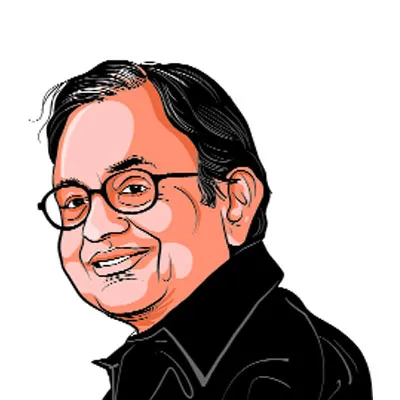Opinion P Chidambaram writes: Whistling in the dark
When the UPA demitted office, at the end of 2013-14 the CAD had been brought down to 1.7%, CPI inflation had been contained at 9.4% (which declined furtherto 5.9% in 2014-15), foreign exchange reserves had increased by $15.5 billion and the exchange rate was Rs 58.4. That is a slice of history for those who want to read history
 According to the RBI’s statistical tables, the current account deficit (CAD) in Q1 amounted to USD 23.9 billion or 2.8 per cent of the estimated GDP, mainly due to the deficit in merchandise trade. (Reuters/File)
According to the RBI’s statistical tables, the current account deficit (CAD) in Q1 amounted to USD 23.9 billion or 2.8 per cent of the estimated GDP, mainly due to the deficit in merchandise trade. (Reuters/File) Whistling in the Dark
The Reserve Bank of India (RBI) was disappointed when the GDP growth rate for Q1 of 2022-23 was below its forecast of 16.2 per cent and recorded 13.5 per cent. For the remaining three quarters, the RBI’s estimates are 6.3, 4.6 and 4.6 per cent.
The estimated average of 7 per cent appears impressive but the truth lies not in the average but in the trend line: note that in quarter after quarter, the growth rate will decline. UNCTAD has a gloomy forecast of 5.7 per cent for 2022 and 4.7 per cent for 2023.
There are parallels. Since demonetization in 2016, the annual growth rates in 2016-17, 2017-18, 2018-19, 2019-20 and 2020-21 were 8.26, 6.80, 6.53, 4.04 and -7.25.
Similarly, the quarterly growth rates since the fourth quarter of 2017-18 were 8.93; 7.56, 6.49, 6.33, 5.84 (2018-19); and 5.39, 4.61, 3.28, 3.01 (2019-20). Take a close look and you will find the declining trend over four fiscal years and eight quarters!
The RBI Tutorial
Sound economic policy is always contextual. While some elements of economic policy in a liberal, market economy will be constant, other elements must be tailored according to the circumstances. Mr Shaktikanta Das, the RBI Governor, has explained the context: “In the last two years, the world has witnessed two major shocks — the Covid 19 pandemic and the conflict in Ukraine. Now, we are in the midst of a third major shock, a storm, arising from aggressive monetary policy actions and even more aggressive communications from advanced economy central banks.” In an era when the United States is the world’s largest economy and the U.S. dollar is the reserve currency, the prudent course is to ‘follow the leader’. The U.S. Fed will not stop raising interest rates until America’s inflation, currently 8.3 per cent, is tamed.
The RBI Bulletin for September 2022 has an essay on the ‘State of the Economy’.
The Introduction reads: “We live in times of conflicting possibilities — elevated inflation and rising recession risks: economic stagnation and increasing debt: strengthening US dollar and weakening currencies in the rest of the world: easing supply chain pressures and reshoring: synchronization in policy actions and deglobalisation: balance sheet normalization and liquidity stress.”
The Daunting Challenges
The above assessment is true for all countries. It is only in India that whistling in the dark is regarded as an effective policy response to the challenges! In this essay, I wish to list the heads under which you may conclude whether the government’s performance deserved a pass or a fail.
Inflation
The RBI’s mandate requires it to keep inflation at 4 plus/minus 2 per cent. Retail price inflation has been above the 6 per cent limit for most of the past 24 months. Wholesale price inflation has been in double digits for nearly 12 months. The current inflation rates are: CPI 7 per cent, WPI 12.37 per cent. At the post-monetary policy press conference, Governor Das candidly admitted, “We expect inflation to come close to the target over a two-year cycle, but there are so many uncertainties” (emphasis mine). Because of differences between the Finance Minister and the RBI about the efficacy of monetary policy the course of inflation management is uncertain.
Current Account Deficit
According to the RBI’s statistical tables, the current account deficit (CAD) in Q1 amounted to USD 23.9 billion or 2.8 per cent of the estimated GDP, mainly due to the deficit in merchandise trade. Preliminary data indicate that the merchandise trade deficit had ballooned to USD 149.5 billion in the period April-September, 2022 (source: MoCI). Gold imports were USD 20 billion. On the POL account, the deficit was USD 65.1 billion. After a promising start in Q1, goods exports in July, August and September have shown a declining trend: USD 36.27, 33.00 and 32.62 billion. At this rate, the CAD for the whole year will exceed 3 per cent and perhaps be close to 3.4 per cent.
Rupee: Dollar Exchange Rate
At the beginning of the fiscal year, the rupee:dollar exchange rate was Rs 75.91. Today, the rate is Rs 82.32. On April 1, 2022, the total foreign exchange reserves were USD 606 billion. By September 30, the total reserves had fallen to USD 537 billion. The RBI has used USD 69 billion to ensure ‘non-volatility’ in the exchange rate market, yet the rupee has depreciated by nearly 8 per cent in six months.
Slowing growth, high inflation, worsening CAD and a falling rupee make the macro-economic picture.
A History Lesson
The situation faced by the country is not without precedent. In 2012-13, thanks to the stimulus packages of FM Pranab Mukherjee, high gold imports and the ‘taper tantrum’ of U.S. Fed Chairman Ben Bernanke, India faced the same triple challenges. When the UPA demitted office, at the end of 2013-14 the CAD had been brought down to 1.7 per cent, CPI inflation had been contained at 9.4 per cent (which declined further to 5.9 per cent in 2014-15), foreign exchange reserves had increased by USD 15.5 billion and the exchange rate was Rs 58.4. That is a slice of history for those who want to read history.






